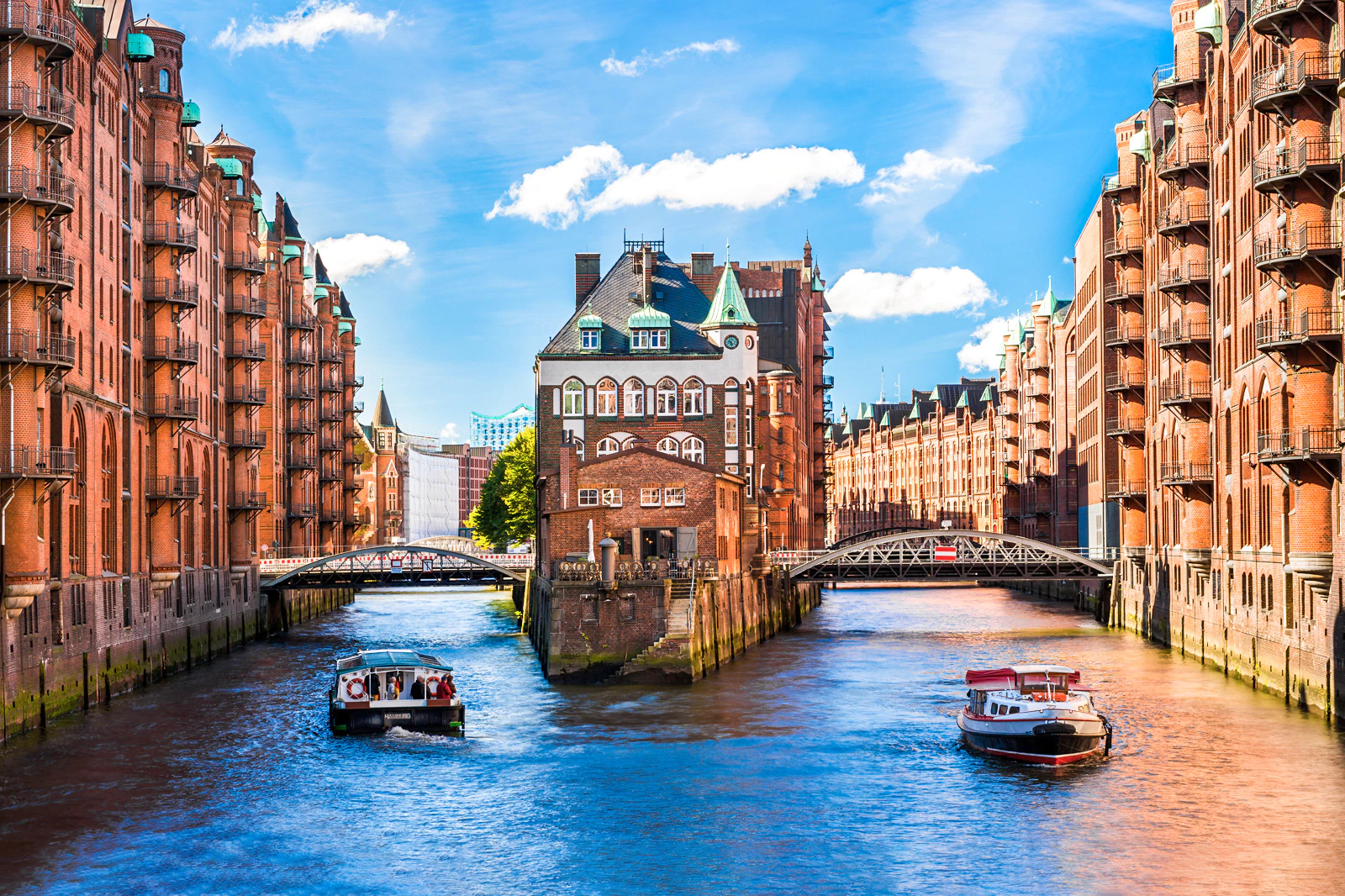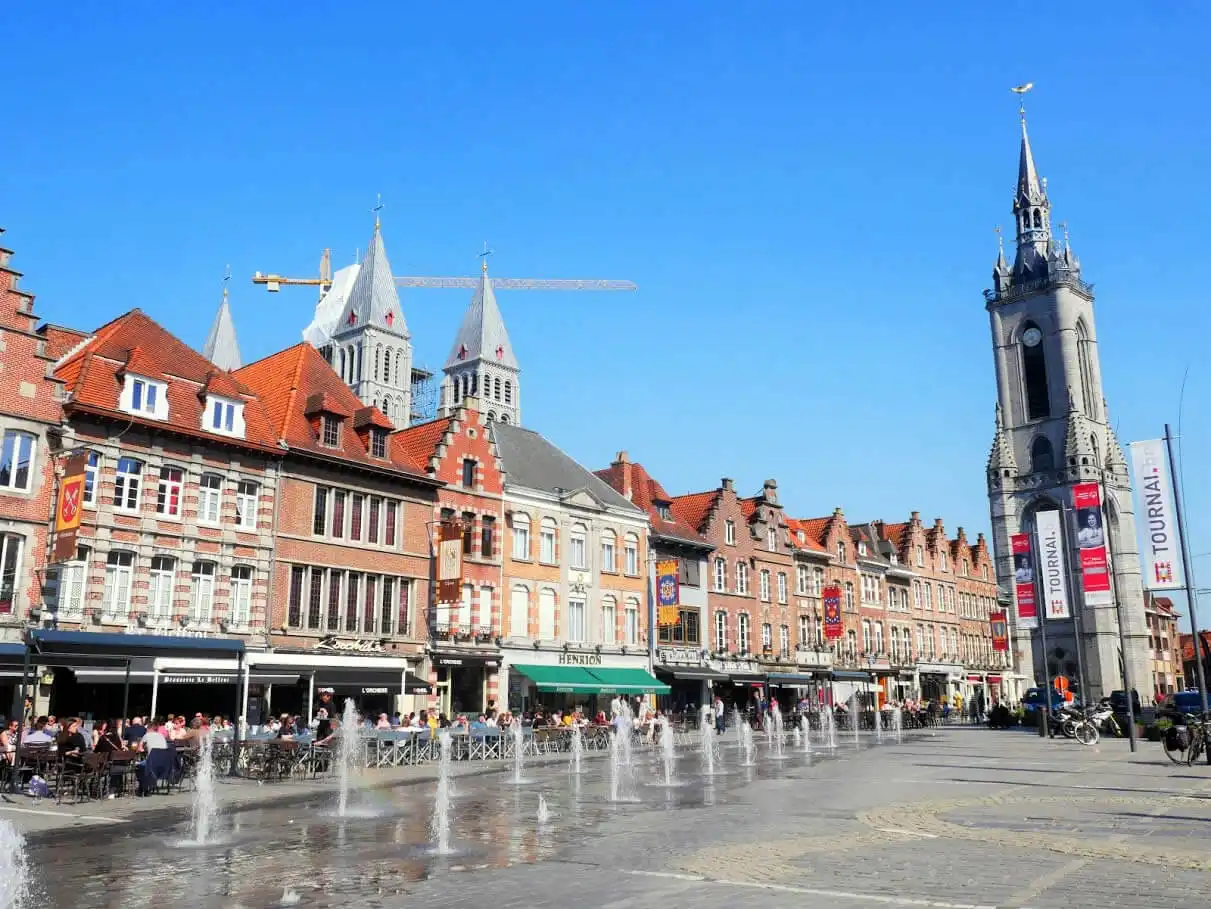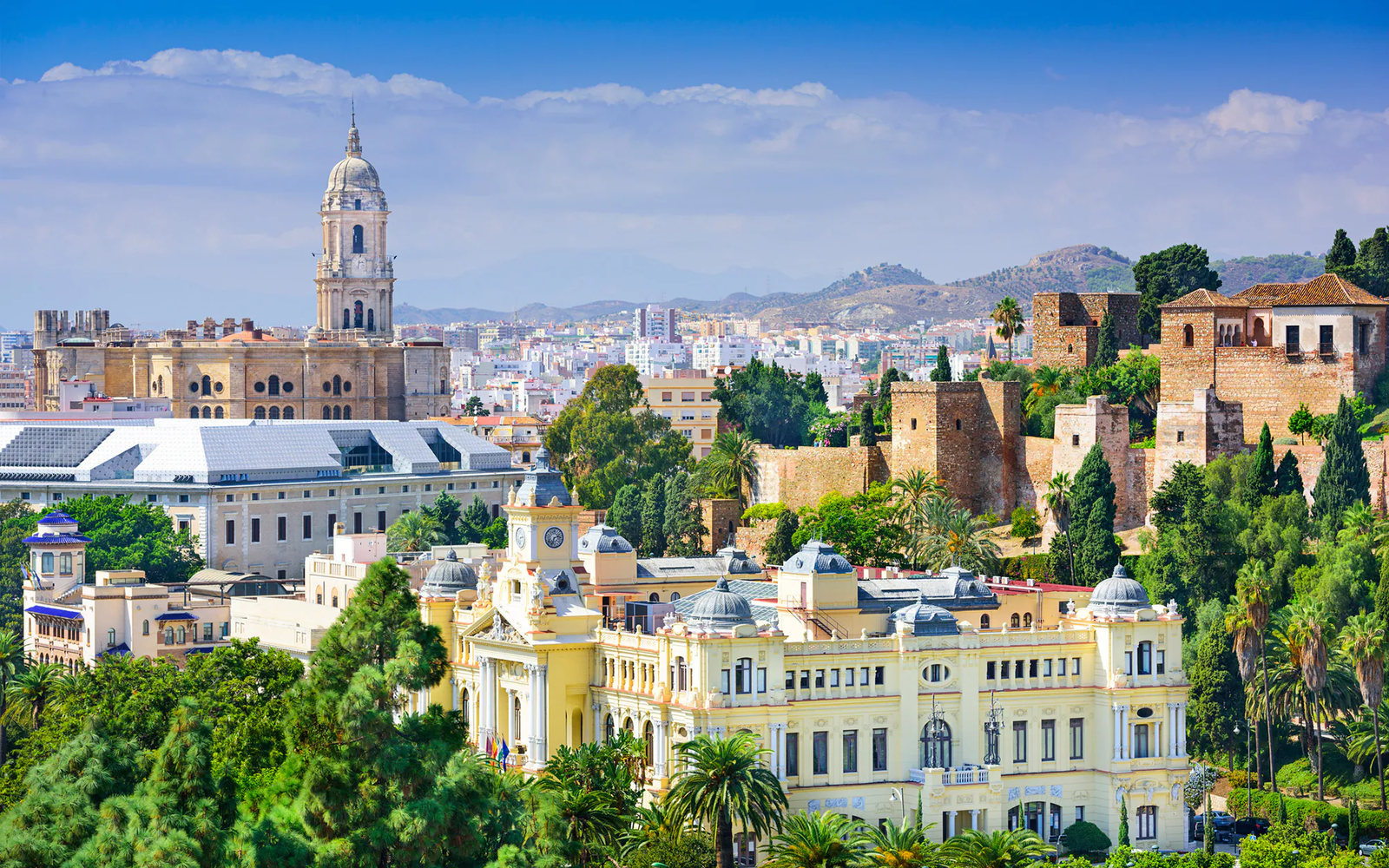Hamburg is Germany’s second largest city and one of Europe’s most dynamic destinations. Located along the Elbe River, Hamburg seamlessly blends its maritime heritage with cutting-edge culture, dining and nightlife.
| No. | Activity | Description |
|---|---|---|
| 1 | Speicherstadt and HafenCity | Explore historic warehouses and modern developments, with harbor cruises. |
| 2 | Elbphilharmonie Concert Hall | Visit the architectural icon for panoramic views and concerts. |
| 3 | Flohschanze Market | Browse Germany’s largest flea market for antiques and food. |
| 4 | St Michaelis Church | Enjoy city views from the Baroque tower and explore its museum. |
| 5 | Miniatur Wunderland | See the world’s largest model railway and diorama attraction. |
| 6 | Planten un Blomen | Relax in a 46-acre park with a Japanese garden and botanical gardens. |
| 7 | Alster Lakes | Cruise or paddle around the Inner and Outer Alster Lakes. |
| 8 | Hamburg State Opera | Experience world-class opera and ballet performances. |
| 9 | Deichstraße | Stroll along a historic harbor street with traditional buildings. |
| 10 | Chilehaus | Tour the iconic German Expressionist office building. |
| 11 | BallinStadt Emigration Museum | Learn about Europe’s emigration history. |
| 12 | Fischmarkt | Shop at a lively riverside market for local specialties. |
| 13 | Old Elbtunnel | Walk through a historic underwater tunnel. |
| 14 | Stadtpark | Cycle around Hamburg’s large green space with various attractions. |
| 15 | Musical Evening | Enjoy Hamburg’s music scene with various genres and venues. |
In 2024, visitors to Hamburg can look forward to new attractions along with classic sites. As you plan your upcoming trip, make sure to include these 15 can’t-miss Hamburg experiences:
Explore Speicherstadt and HafenCity

Speicherstadt and HafenCity: A historic warehouse district and site of Europe’s largest continuous warehouse complex, located on Hamburg’s waterfront along with the new HafenCity development.
History and Significance: Speicherstadt was developed in the late 19th century to consolidate Hamburg’s status as a leading port city. Its warehouses stored spices, carpets, and other goods. HafenCity is a new waterside development with residential, commercial, and cultural sites. Together they showcase Hamburg’s maritime heritage.
What to Expect: Visitors can wander the brick warehouses of Speicherstadt crossed by fleets and canals. HafenCity has striking modern architecture, promenades, and the Elbphilharmonie concert venue. Museums like the Hamburg Dungeon and Miniatur Wunderland are also located here.
Visitor Information: Guided boat tours of the warehouse district are available. Speicherstadt and HafenCity are adjacent to the city center, walkable or easily reached by public transit.
Wander through Hamburg’s historic warehouse district, Speicherstadt, a UNESCO site with Gothic Revival architecture built on oak piles. Nearby HafenCity is one of Europe’s biggest urban development projects with sparkling concert halls, museums, restaurants and residential areas popping up on former docks. Don’t miss a harbor cruise to admire it all from the water.
Tour the New Elbphilharmonie Concert Hall

Elbphilharmonie Concert Hall: An architecturally stunning performance venue located in Hamburg’s HafenCity area.
History and Significance: The Elbphilharmonie was completed in 2016 after years of construction. Its uniquely shaped glass structure sits atop a historic warehouse, becoming an iconic landmark on Hamburg’s waterfront. It is home to world-class acoustics and a diverse program of concerts and events.
What to Expect: The Plaza viewing platform offers 360-degree panoramas over the city and harbor. There are guided tours of the concert halls and backstage areas. The Great Concert Hall hosts performances by leading orchestras, soloists, and bands.
Visitor Information: The Plaza is open daily. Guided tours and advance tickets to concerts should be booked online. The Elbphilharmonie is located in HafenCity, easily reached by public transport.
This shimmering glass masterpiece designed by Herzog & de Meuron atop an old warehouse is Hamburg’s brand-new architectural icon. Take the escalator up through the wavy structure to the public viewing platform for panoramic port vistas. Experience the astounding acoustics at a concert in one of the Elbphilharmonie’s halls, opening in early 2024. Even just seeing the exterior is a must.
Browse the Antiques at Flohschanze

Flohschanze Antique Market: A large outdoor flea market in Hamburg selling antiques, second-hand goods, crafts, food, and more.
History and Significance: Flohschanze evolved from informal antique sales in the lively Schanzenviertel district into a popular weekend market attracting treasure-hunters. It offers a wide selection of unique vintage and antique finds.
What to Expect: Hundreds of vendors sell antiques, jewelry, furniture, art, clothing, books, and bric-a-brac each Saturday and Sunday. There is something for every price range. The bustling market has food stands and a festive atmosphere.
Visitor Information: Flohschanze is located in Hamburg’s Schanzenviertel and easily reached by public transport. Opening hours are Saturdays from 8 am to 4 pm and Sundays 9 am to 4 pm. Entry is free.
Germany’s largest flea market located in the lively Schanzenviertel neighborhood takes place on weekends. Here you’ll find vendors selling retro furniture, artwork, jewelry, clothing, vinyl records, knickknacks and more curiosities. Wandering the stalls is a fun way to spend a morning. Don’t forget to browse the food stands for bratwurst and beer while bargain hunting.
Take in the Views from St Michaelis Church

St. Michaelis Church: A famous Protestant baroque church and landmark of Hamburg’s skyline.
History and Significance: St. Michaelis is known as the “Michel.” It was first built in the 17th century and rebuilt after fires and WW2 damage. Its 132-meter tower is the city’s highest point and offers panoramic views. The church is an iconic Hamburg symbol.
What to Expect: Visitors can see the elaborate interior, climb the 450 steps up the tower for scenic vistas, attend services and concerts, and visit the crypt. The clock tower is illuminated at night.
Visitor Information: The church is open daily. Guided tours and tower climbs require tickets purchased in advance online. Located near the port, the Michel is a short walk from the train station.
The Baroque tower of St. Michaelis Church acts as a beacon above Hamburg’s skyline. Climb the steps to the outdoor viewing platform for awe-inspiring panoramas over the city’s sea of red tiled roofs and massive port. The crypt contains elaborate silver sarcophagi and the tower museum explores the church’s stormy history. Concerts using the church’s massive organ are also a highlight.
Explore Miniatur Wunderland

Miniatur Wunderland: The largest model railway exhibit in the world, with huge, highly detailed miniature landscapes.
History and Significance: Created by twin brothers, Miniatur Wunderland opened in 2001 and has expanded to over 15,000 square meters of exhibits. It attracts over a million visitors annually, making it one of Hamburg’s top attractions.
What to Expect: Massive model railway layouts featuring detailed recreations of places like Hamburg, the US, Scandinavia, and more. There are trains, planes, ships, cars, and thousands of tiny human figurines engaged in action. New sections are constantly under development.
Visitor Information: Located in Speicherstadt. Open daily; purchase advance tickets online to guarantee entry. The exhibits have details to occupy hours of exploration.
Even if you don’t have kids, you’ll be amazed by Miniatur Wunderland, the world’s largest model railway and diorama attraction. Marvel over the intricate little details in the miniature scenes ranging from Hamburg’s port to Las Vegas to Scandinavia. New for 2023 is an expanded section recreating Italy. Be sure to admire the model airport complete with landing planes. Truly a small world wonder!
Relax at Planten un Blomen

Planten un Blomen: A large urban park and botanical garden located in central Hamburg.
History and Significance: Planten un Blomen was created in 1821 on the site of Hamburg’s old fortifications. It expanded in the 20th century to become a 47-hectare green oasis with diverse gardens and facilities. The park hosts popular festivals and events.
What to Expect: Sprawling lawns, rose garden, Japanese garden, tropical greenhouse, botanical exhibits, ponds/fountains, cafe, playgrounds, and seasonal displays like the water light show. Relaxation and recreation in natural surroundings right in the city center.
Visitor Information: The park is open daily and admission is free. Easily reached by public transport; the main entrance is opposite the Dammtor train station.
This lush 46-acre inner city park makes for a perfect leisurely stroll or picnic stop. Be sure to visit the Japanese garden section with bonsai trees, rock gardens and a traditional tea house. The adjacent botanical garden contains tropical plants in greenhouses as well as outdoor gardens organized by theme. In summer, live music plays in the park’s open-air theater.
Cruise Around the Alster Lakes

Alster Lakes: Two artificial lakes in Hamburg that are popular recreation destinations for boating, walking, and relaxing.
History and Significance: The larger Aussenalster and smaller Binnenalster have been part of Hamburg since the 13th century. They define the city’s character and are home to sailing clubs and rowing regattas. The lakes’ surroundings feature beautiful homes, greenery, cafes, and walking/cycling paths.
What to Expect: Lakeside trails, boat cruises, waterside dining, public swimming areas, and green park spaces. A leisurely atmosphere amidst the city bustle. Walking across Lombard Bridge offers scenic views.
Visitor Information: The lakes are located right in the city center, ringed by parks and attractions. Public transport options are plentiful. Boat rentals and tours available in summer.
The Inner and Outer Alster Lakes located right in Hamburg’s city center make for a rejuvenating escape. Rent your own boat, kayak or paddleboard and admire the city views and stately lakeside mansions. Alternatively, take a narrated sightseeing cruise or hop aboard the Alster Touristik ferry to cruise between lakeside landmarks. Finish with lunch along the shore.
See a Show at Hamburg State Opera

Hamburg State Opera: A prestigious venue for opera, ballet, and classical music performances in Hamburg.
History and Significance: The opera house opened in 1955. It is home to the Hamburg State Opera company and the Hamburg State Philharmonic Orchestra. With acclaimed acoustics and programming, it is one of Germany’s leading opera houses.
What to Expect: Attending opera, ballet, concerts, or recitals in a beautiful performance hall. Productions range from classic to modern. Tours are offered on non-performance days.
Visitor Information: Located next to the Gänsemarkt square. Tickets can be purchased online in advance. The venue is accessible by public transportation.
Treat yourself to a world-class performance at the Hamburg State Opera. This elegant Neo-Renaissance venue presents over 200 opera and ballet productions per season, including both classic and experimental shows. Arrive early to admire the marble foyer and crystal chandeliers before being swept away by the soaring vocals, lavish costumes and evocative orchestra.
Discover Deichstraße

Deichstraße: A scenic street along the waterfront in Hamburg’s Altstadt historic district.
History and Significance: Deichstraße runs along the Nikolaifleet canal, offering romantic water views in Hamburg’s oldest neighborhood. Historic gabled houses and landmarks line the street. It’s a lovely area for a stroll.
What to Expect: Pedestrianized cobblestone street featuring cafes, restaurants with outdoor seating, small shops, and street musicians. Picturesque waterfront setting and charming old architecture.
Visitor Information: Deichstraße is in central Hamburg, walkable from the train station or easily reached by public transport.
For a uniquely Hamburg experience, stroll along Deichstraße in the historic harbor neighborhood to see streets lined with traditional brick warehouses raised on stilts. Walkways cross over water-filled canals weaving between the picturesque buildings. Stop for fish sandwiches and harborside drinks at one of the many casual restaurants built right over the water.
Tour the Historic Chilehaus

Chilehaus: A distinctive Hamburg building designed in the Expressionist style, resembling an ocean liner.
History and Significance: The Chilehaus office building was constructed 1922-1924 for a trading firm. Its curved facades and stair-stepped shape make it an important landmark of Brick Expressionism architecture.
What to Expect: Viewing and photographing the imposing ten-story Chilehaus from the street. The building’s unique design stands out among Hamburg’s historic Kontorhaus office buildings.
Visitor Information: Chilehaus is located in Hamburg’s business district and can be easily reached by public transportation.
This distinctive 10-story office building constructed in 1924 resembles the prow of a massive ship. The Chilehaus is an iconic example of German Expressionist architecture with its soaring curved façade, angular shapes and elaborate brickwork ornamentation. Take the U-Bahn to Meßberg to see the Chilehaus and surrounding Kontorhaus district up close.
Marvel at Miniature Wunderland

Even those without kids will be amazed by Miniatur Wunderland, the world’s largest model railway attraction. This mind-blowing miniature world crafted with painstaking detail spans over 15,000 square feet and replicates regions like Germany, Las Vegas, Scandinavia and Italy. New expansions open annually. Be sure to see the model airport with its tiny planes actually taking off and landing!
See BallinStadt Emigration Museum

BallinStadt Emigration Museum: Museum about Hamburg’s emigration history, located on the site where emigrants once departed.
History and Significance: Over 5 million people emigrated via Hamburg from 1850-1939. BallinStadt documents their stories. The former emigrant halls opened as a museum in 2007.
What to Expect: Exhibits using models and multimedia to recreate the experience of emigrants. Artifacts, personal accounts, recreated living quarters. Genealogy services available.
Visitor Information: In the Port of Hamburg, short ride on public transport from the city center. Open daily, tickets purchased online in advance.
Gain perspective on Hamburg’s role as the “Gateway to the World” at BallinStadt, located on the original site where millions of Europeans departed for America. Exhibits here recreate the cramped ship quarters while documenting the immigrant experience. Special exhibits highlight stories of specific groups like Hungarian Jews. Be sure to watch the short film about founder Albert Ballin.
Explore the Fischmarkt

Fischmarkt: A lively fruit and fish market in Hamburg that takes place every Sunday morning.
History and Significance: Hamburg’s Fischmarkt dates back to 1703. The bustling open-air market retains a traditional character, with vendors auctioning off fish and produce brought in overnight. A popular weekend activity.
What to Expect: Vendors loudly hawking fresh seafood, fruits and vegetables, flowers and snacks. Musicians and entertainment add to the festive atmosphere. An early morning Hamburg tradition.
Visitor Information: Located in St. Pauli near the Reeperbahn. Takes place Sundays 5am-9:30am. Easily reached by public transport.
Rise early on Sunday mornings to join locals shopping for flowers, fruit, seafood and regional specialties at Hamburg’s lively Fischmarkt. Dating back 300 years, vendors pack the bustling riverside market while bands perform and barges haul in fresh North Sea catch. Sip German beer and dance along with the convivial fish market crowd before the vendors pack up at lunchtime.
See Hamburg’s Old Elbtunnel

Old Elbtunnel: A vintage underground pedestrian tunnel crossing the Elbe River.
History and Significance: Constructed 1906-1911, the 426-meter navigable Elbtunnel was an engineering landmark allowing commerce to cross the river. Its decorative vintage details make it a popular tourist attraction.
What to Expect: Descending on elevators, walking through the tiled tunnel lined with brass lights while ships pass overhead. Emerging on the harbor’s south bank.
Visitor Information: Located at Landungsbrücken pier, open 24/7. Admission is free. Can be reached by foot, public transport, or passenger ferry.
This marvel of early 20th century engineering is a beloved Hamburg landmark. The sprawling 426-meter tunnel was built in 1911 to carry cars, pedestrians and even horses under the Elbe River. Take the vintage wood-paneled elevator down and walk through while imagining life in the early 1900s. Exhibits upstairs detail the tunnel’s construction and technology, which was extremely advanced for the time.
Cycle Around Stadtpark

Stadtpark: Hamburg’s main public park, covering nearly 60 hectares near the Alster Lakes.
History and Significance: Originally laid out in 1914, Stadtpark mixes English-style landscaping with floral displays. It is a popular spot for recreation and events like concerts, festivals, and sporting activities. What to Expect: Walking trails, meadows, trees, flower gardens, duck ponds, play areas. Relaxing escapes from the city within easy reach. Visitor Information: Next to central Hamburg, easily walkable or reached by transit. Open year-round; cafes and attractions have seasonal hours.
Escape the city bustle with a leisurely bike ride around Stadtpark, Hamburg’s lively 161-acre green space. Pedal past swimmers along the Alster lakefront, tree-lined paths, rose gardens and grassy lawns. Other park highlights include a planetarium, performing arts theater and remnants of ancient city fortifications. It’s especially lovely when tulips are blooming in springtime.
Savor a Musical Evening

Musical Evening: Hamburg is renowned for its vibrant music and theater scene, with world-class venues.
History and Significance: Opera, ballet, and orchestral performances can be seen at the Hamburg State Opera House. The Elbphilharmonie and Laeiszhalle host concerts. Hamburg has a thriving rock/pop music culture. The Reeperbahn district is known for musical theaters and clubs.
What to Expect: An inspiring evening enjoying culture and music, from classical to contemporary. Concert halls provide rich acoustic experiences. Clubs feature up-and-coming bands.
Visitor Information: Major venues are located in the city center. Tickets for popular events should be booked in advance online. Public transportation provides easy access.
Few cities can match Hamburg’s vibrant music and theater scene. Take your pick from acclaimed productions at the Hamburg State Opera, cutting-edge rock concerts, jazz combos or musical theater. The iconic Elbphilharmonie and Laeiszhalle host world-class orchestras and classical performances. For impromptu entertainment, swing by the Reeperbahn area’s legendary clubs and variety shows. With so many options, the challenge is choosing!
Conclusion
With its blend of regal historic architecture, modern waterfront developments, green spaces, museums and non-stop entertainment, Hamburg entices visitors with opportunities for unique experiences. Marienkirche’s towering spire, Speicherstadt’s canal-laced warehouses and Miniatur Wunderland’s tiny marvels reveal the many sides of this dynamic port city. When planning your 2024 travels, save time for savoring new attractions like the Elbphilharmonie plus old favorites like lingering over coffee near bustling Jungfernstieg. Hamburg’s welcoming cosmopolitan energy promises a fulfilling journey.





Join the Conversation